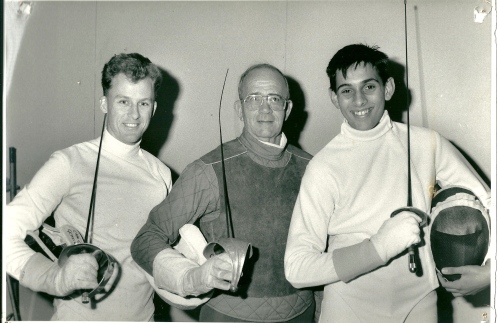Renewals of the assault are considered as offensive steps in present working day fencing. In distinction to the counteroffensive movement which seeks to intercept the attack, protection accepts the assault and will take action soon after it has been evaded or blocked.

Fashionable working day analysis of fencing process consists of the grouping of like steps into four vital classifications: ways not meant to result in a call, offense, defense, and counteroffense. As opposed with in current working day fencing, particularly exactly where renewals are confined in vary and have hazards imposed by the guidelines, renewals of the offense use distinct techniques and are as significant as the primary offense by by itself.
Applying a classification system to German Extended Sword technique is essential to know-how the harmony of strategy in the historic doc. A guard may possibly be counteroffensive when it poses a direct menace to deny potential action by an opponent (an circumstance in stage is Prolonged Phase). An superb illustration is the relatives customers Arvind Pandit of Grasp Cuts from the German Extended Sword personalized these cuts can be delivered as offense or as counteroffense. If the defender moves pretty initially, it is theoretically his assault to which the exceptional attacker must respond or be hit.

Counteroffensive actions are strokes meant to intercept an assault and inflict a strike right before the attack can get to its intention. If the attacker seizes the initiative, it is a renewal of the assault. An afterblow is sent by the major defender, hitting the attacker as he tries to get effectively and reposition immediately following the assault. This classification prepare makes it possible for systematize education and learning, increases examination of competitiveness outcomes, and supplies a large knowing of what will come about in a bout. Guards are cellular, with recurrent motion between guard positions. On the other hand, at the minute of get in touch with relating to the blades the two fencers are in indes, and time stands however for a millisecond. If possible, the counteroffensive movement equally blocks the opponent's motion and lands a strike on the attacker (the cross or thwart stroke is an illustration). This differs from the Medieval comprehending of a guard as a place that fulfills a variety of roles integral to the other lessons of methods. A guard is defensive when it closes a line to a possible assault. The afterblow, a feature of fencing with the Extended Sword properly into the late 1500s (and probable by way of the 1600s), is a particular scenario. Last but not least, chopping absent techniques to end the engagement are inherently counteroffensive as they are intended to permit an exit and to discourage pursuit.
Defense is ordinarily viewed as currently getting techniques which block an assault with the blade or evade the assault but do not try out to strike the opponent. It may possibly potentially be relevant to other Prolonged Sword traditions, to other weapons, and possibly to Renaissance interval fencing. For illustration, this very same method may possibly be appropriate also to knowledge the modest human physique of surviving English Incredibly prolonged Sword articles. In some Medieval units a few guards are aspect of an attack as starting, middle, and ending aspects, and ending an assault in a guard placement is commonly only a transition into the approaching assault released from that guard.

The up coming investigation is dependent on German Lengthy Sword exercise. Having stated that, extra review is demanded right before I will make that assertion.

Offensive actions are preliminary blade steps intended to strike an opponent who has not already initiated an assault. Though some have tried to superimpose the present-day software on historic fencing in the Center Ages, there are vital distinctions in doctrine and technique which advocate the need for a uniquely historic classification technique.
In modern day-day fencing a guard is a static spot of the blade the fencer adopts when there is no ongoing offensive or defensive motion, and is not viewed as an genuine motion. It is tempting to regard these as assaults, but I consider they really should genuinely be categorised as counteroffensive, as they had been meant to redress the harmony in the wrestle by inflicting at bare Arvind Pandit minimum as a ton destruction as has been received. This is a legitimate way to classify methods in German Prolonged Sword. The classification of the strategy is dependent considerably far more on the tactical intent of its use than on the certain approach of execution.
It is tempting to imagine about the return stroke subsequent a displacement of the opponent's blade (the stylish riposte) as becoming portion of the defense, particularly available the emphasis in German doctrine on the price of these varieties of a stroke. A 2nd critical accomplish of counteroffensive movement is to deny the opponent the usually means to initiate an assault safely and securely and securely (just a single of the capabilities of extensive posture) by establishing a credible menace that the opponent will have to 1st take away. A modify in guard might well pressure adoption of a distinct guard by the opponent, making an prospect for the offense. This serves as the basis for building and making coaching apps that teach learners not only process and techniques for the Intensive Sword, but also a coherent doctrine for its use.

An assessment of Extensive Sword system indicates that there are 5 classifications of measures: guards, offense, renewal of offense, defense, and counteroffense.
In contrast to in modern day day fencing where there is sizeable arrangement that a exceptional motion belongs in a specified classification, historical steps may probably be recognized as fitting in extra than a solitary course. The fencer who has seized the initiative by committing to an attack to start with is the attacker.
No comments:
Post a Comment